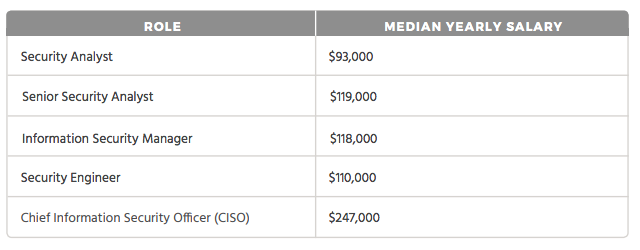Last updated at Thu, 21 Dec 2023 22:35:16 GMT
Security operations (SecOps) is the workhorse of an organization, working tirelessly to keep systems secure and connected, employees safe, and data locked down. However, more systems, applications, and data means more alerts and issues that security operations teams need to contend with. Before long, budgets balloon out of control as additional resources are needed just to keep up. While more and more companies are giving security its fair share of the budget these days, many still can’t afford large teams or exponential costs.
1. People: Your bread and butter
If your current security operations are mostly manual, one of the most expensive and complex parts of your security investment is personnel. This is in large part due to the security talent shortage driving up salaries, but all the same, people are expensive.
Take a look at the chart below, which details median salaries in a major city like Boston, and you can see why a good chunk of the security budget goes here:

If your hard-earned security analyst is spending most of the day manually reviewing and investigating routine alerts, you're making a nearly $90,000 investment per year in alert investigations alone—assuming you have just one security analyst doing this. Sorting through endless alerts day after day is also mind-numbing work, which can lead to employees missing the real threats that cause even more expensive damage.
One way to offload these manual tasks and make better use of your valuable employees is to leverage a a security orchestration and automation (SOAR) solution. When implemented correctly, a SOAR solution can free up employees’ time to focus on strategic, value-add projects that make a bigger impact on your security posture.
2. Processes: How things get done
While essential for getting work done, processes can be quite resource-intensive to develop. The first, and arguably most difficult, step is defining what the process is in the first place. This often requires numerous meeting with different stakeholders to understand which alerts, domains, ticketing systems, machines, files, etc., are involved in each process, and then obtaining access to each of those so you can develop and execute the process.
Once a process is created, it needs to be tested and regularly maintained, which can also be tedious. Add this to the time your team already spends tending to alerts, and you have a pretty pricey security program on your hands.
But, we can’t forgo processes—after all, they tie together the entire security organization. This is another area in which orchestration and automation can be a big boost. You'll still need to put in the leg work up front to define a process, but do it once and a SOAR solution will help you leverage it into the future. Whether you’re using pre-built or in-app automation capabilities, or building it yourself, all you should have to do in the end is plug in your tools and define the repeatable processes, and it handles the rest. As we explain in our Security Orchestration and Automation ROI Whitepaper, this can save you a great deal of time right away.
3. Technology: Your catalyst to progress
The third category most security operations teams spend a great deal of their resources on is technology. From threat hunting, to phishing investigations, to patching and remediation, to malware analysis, there are many things needed to get your job done. What most companies don’t realize is cost includes not only the initial cost, but any recurring, maintenance-based costs as well.

Add on the fact that most security teams aren’t using each tool to its full potential, and there’s a lot of waste here—that is, unless you have a clever way of integrating them all together so they can share and correlate information.
This is another area where SOAR offers ROI. An orchestration and automation solution should offer both pre-built integrations to easily connect the tools you're already using. This allows you to maximize the value of your tech stack, while eliminating the need to build custom integrations or perform manual tasks in lieu of integrations.
DIY vs. automated security operations
Whether you’ve experienced it yourself yet or not, manual security operations are not the most efficient or effective way to move security forward. Doing it yourself may seem appealing at the get-go, but the costs can quickly add up and the margin of error is high. That’s why more and more organizations are turning to SOAR to take advantage of all that automation offers, without the costs of DIY’ing it.
SOAR helps you maximize your investments in people, processes, and technology—and it can help you get it all done faster and with more accuracy.
